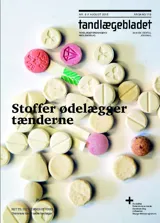Effekten af (de)kontaminering med saliva på bindingsstyrken til dentin fra primære og permanente tænder
Kontaminering med saliva havde ingen negativ virkning på bindingsstyrken af Scotchbond Universal. Der var ingen forskel mellem primære og permanente molarer, hvad angik bindingsstyrken til dentin. Dentin, der er blevet kontamineret med saliva, bør skylles med vand og blæses tør, hvorefter adhæsivet genappliceres.
Introduktion og formål
Salivakontaminering kan forekomme under fremstilling af en plastfyldning, såfremt der ikke anvendes kofferdam. Formålet med denne undersøgelse var at vurdere effekten af kontaminering med saliva og af to dekontamineringsprocedurer på bindingsstyrken af komposit plast til primær og permanent dentin formidlet af to selvætsende ettrins adhæsiver.
Materiale og metoder
Ekstraherede primære og permanente molarer (210 af hver) blev slebet plane okklusalt fra indtil ca. midt i dentinen, og de slebne molarer blev delt ind i syv grupper (n = 15/gruppe/molartype) for hver af de to adhæsiver (Xeno V+ og Scotchbond Universal): ingen kontaminering med saliva (kontrol), kontaminering med saliva enten før eller efter lyspolymerisering af adhæsivet efterfulgt af luftpåblæsning eller efterfulgt af skylning med vand og fornyet luftpåblæsning eller af skylning med vand, luftpåblæsning samt genapplicering af adhæsivet. En cylinder af komposit plast (Filtek Z250) blev herefter polymeriseret fast på de behandlede dentinoverflader, og prøvelegemerne blev opbevaret ved 100 % relativ fugtighed og 37 °C. Efter 24 timer blev bindingsstyrken målt ved forskydning, og resultaterne blev analyseret statistisk med en nonparametrisk variansanalyse efterfulgt af exact Wilcoxon Rank Sum Tests (α = 0,05).
Resultater og konklusion
I kontrolgruppen uden salivakontaminering gav Xeno V+ signifikant højere bindingsstyrke end Scotchbond Universal. Salivakontaminering reducerede bindingsstyrken af Xeno V+ så meget desto mere, når kontamineringen fandt sted inden lyspolymerisering end efter lyspolymerisering af adhæsivet. I begge tilfælde genetableredes bindingsstyrken som følge af den af de to dekontamineringsprocedurer, der inkluderede genapplicering af adhæsivet. Kontaminering med saliva havde ingen negativ virkning på bindingsstyrken af Scotchbond Universal. Der var ingen forskel mellem primære og permanente molarer, hvad angik bindingsstyrken til dentin. Dentin, der er blevet kontamineret med saliva, bør skylles med vand og blæses tør, hvorefter adhæsivet genappliceres.
Effect of salivary contamination and decontamination on bond strength of two one-step self-etching adhesives to dentin of primary and permanent teeth
Introduction and purpose – When placing an adhesive restoration in the absence of a rubber dam, contamination of the cavity with saliva is a risk. The purpose of this in vitro study was to evaluate the effects of human saliva contamination and two decontamination procedures at different stages of the bonding procedure on bond strength of two one-step self-etching adhesives to primary and permanent dentin.
Material and methods – Extracted human primary and permanent molars (210 of each) were ground to mid-coronal dentin. The dentin specimens were randomly divided into seven groups (n = 15/group/molar type) for each adhesive (Xeno V + and Scotchbond Universal): no saliva contamination (control); saliva contamination before or after light curing of the adhesives followed by air drying, by rinsing with water spray and air drying, or by rinsing with water spray, air drying and reapplication of the adhesives. Resin composite (Filtek Z250) was applied on the treated dentin surfaces. The specimens were stored at 37°C and 100% humidity for 24 h. After storage, shear bond strength (SBS) was measured and data analyzed with nonparametric ANOVA followed by exact Wilcoxon rank sum tests.
Results and conclusion – Xeno V + generated significantly higher SBS than Scotchbond Universal when no saliva contamination occurred. Saliva contamination reduced SBS of Xeno V + , the reduction being more pronounced when contamination occurred before light curing than after. In both situations, decontamination involving reapplication of the adhesive restored SBS. Saliva contamination had no significant effect on Scotchbond Universal. There were no differences in SBS between primary and permanent teeth. Based on this study the following procedure is recommended on saliva- contaminated dentin: Rinsing with water and air drying followed by reapplication of the adhesive.


